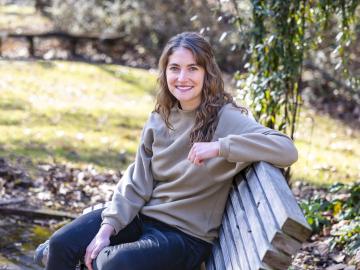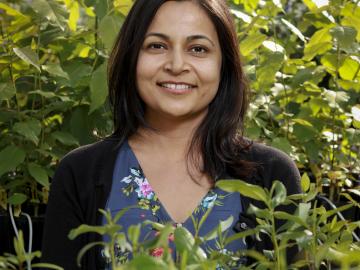
Filter News
Area of Research
News Type
News Topics
- 3-D Printing/Advanced Manufacturing (1)
- Advanced Reactors (1)
- Artificial Intelligence (1)
- Big Data (1)
- Bioenergy (3)
- Biology (2)
- Biotechnology (2)
- Buildings (2)
- Chemical Sciences (2)
- Clean Water (1)
- Climate Change (4)
- Computer Science (2)
- Decarbonization (3)
- Energy Storage (1)
- Environment (4)
- Exascale Computing (1)
- Frontier (1)
- Fusion (1)
- High-Performance Computing (1)
- Isotopes (2)
- Machine Learning (1)
- Mathematics (1)
- National Security (3)
- Nuclear Energy (2)
- Polymers (1)
- Security (1)
- Sustainable Energy (1)
Media Contacts

Alyssa Carrell started her science career studying the tallest inhabitants in the forest, but today is focused on some of its smallest — the microbial organisms that play an outsized role in plant health.

ORNL’s Assaf Anyamba has spent his career using satellite images to determine where extreme weather may lead to vector-borne disease outbreaks. His work has helped the U.S. government better prepare for outbreaks that happen during periods of extended weather events such as El Niño and La Niña, climate patterns in the Pacific Ocean that can affect weather worldwide.

Canan Karakaya, a R&D Staff member in the Chemical Process Scale-Up group at ORNL, was inspired to become a chemical engineer after she experienced a magical transformation that turned ammonia gas into ammonium nitrate, turning a liquid into white flakes gently floating through the air.

Cushman, a Liane B. Russell Fellow at ORNL, has been studying trees and forests in an effort to help humans care for them and improve the health of the planet. Cushman’s fellowship research at ORNL aligns with that, utilizing ground, air and space platforms to study trees and forests in the Southeast.

Although he built his career around buildings, Fengqi “Frank” Li likes to break down walls. Li was trained as an architect, but he doesn’t box himself in. Currently he is working as a computational developer at ORNL. But Li considers himself a designer. To him, that’s less a box than a plane – a landscape scattered with ideas, like destinations on a map that can be connected in different ways.

Chelsea Chen, a polymer physicist at ORNL, is studying ion transport in solid electrolytes that could help electric vehicle battery charges last longer.

Ilenne Del Valle is merging her expertise in synthetic biology and environmental science to develop new technologies to help scientists better understand and engineer ecosystems for climate resilience.

Louise Stevenson uses her expertise as an environmental toxicologist to evaluate the effects of stressors such as chemicals and other contaminants on aquatic systems.

It’s been 10 years since the Department of Energy first established a BioEnergy Science Center (BESC) at Oak Ridge National Laboratory, and researcher Gerald “Jerry” Tuskan has used that time and the lab’s and center’s resources and tools to make good on his college dreams of usi...



